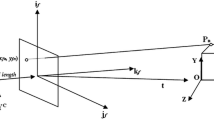Abstract
Much of the dynamic computer vision literature deals with the determination of motion and structure by observing two frames captured at two instants of time. Motion prediction and understanding can be improved significantly, particularly in the presence of noise, by analyzing an image sequence containing more than two frames. In this paper, we assume knowledge of correspondence of points on the surface of an object which is moving with constant motion, i.e., constant translation and constant rotation around an unknown center. We give a new formulation of the problem and prove that the following results hold in general for the number of solutions to motion and structure values (i.e., values of translation, rotation, and depth):
(a) For three point correspondences over three views, there are at most two solutions, only one of which has all positive depth values;
(b) For two point correspondences over four views, there is a unique solution;
(c) For one point correspondence over five views, there can be up to ten solutions;
(d) For one point correspondence over six views, there is a unique solution.
The method of solution for each of the above formulations requires the solving of a system of multivariate polynomials, whose coefficients are functions of the observed data. In order to determine the number of solutions to these systems, we use theorems from algebraic geometry which imply that under a few mild conditions, the number of solutions at one set of data points provides an upper bound on the number of solutions for almost all sets of data points.Thus a bound on the number of solutions is obtained when a single system is solved by a method such as homotopy continuation, which we use here.
Similar content being viewed by others
References
Aggarwal, J. K. and Nandhakumar, N. 1988. On the computation of motion from sequences of images-A review. Proc. IEEE, Vol. 76, pp. 917-935.
Bogen, R. et al. 1983. MACSYMA Reference Manual. Symbolics Incorporated: Cambridge, MA.
Borel, A. 1969. Linear Algebraic Groups. W. A. Benjamin Inc.: Amsterdam.
Broida, T. J. and Chellappa, R. 1986. Kinematics and structure of a rigid object from a sequence of noisy images. Proc. IEEE Workshop on Motion, Kiawah Island, S. C., pp. 95-100.
Buchberger, B. 1979. A criterion for detecting unnecessary reductions in the construction of Gröbner bases. In Symbolic and Algebraic Computation (Proceedings of EUROSAM 79). Lecture Notes in Computer Science, Springer-Verlag: Berlin, Vol. 72, pp. 3-21.
Canny, J. 1988. The Complexity of Robot Motion Planning. MIT Press: Cambridge, MA.
Char, B. W., Geddes, K. O., Gonnet, G. H., Monagan, M. B., and Watt, S. M. 1985. Maple User's Guide, Watcom Publications Limited: Waterloo, Ontario.
Hartshorne, R. 1977. Algebraic Geometry. Springer-Verlag: New York.
Hoffman, D. D. and Bennett, B. M. 1986. The computation of structure from fixed-axis motion: Rigid structures. Biological Cybernetics, 54:71-83.
Holt, R. J. and Netravali, A. N. 1991. Camera calibration problem: Some new results. CVGIP: Image Understanding, 54: 368- 383.
Holt, R. J. and Netravali, A. N. 1993. Motion from optic flow: Multiplicity of solutions. Journal of Visual Communication and Image Representation, 4: 14-24.
Horn, B. K. P. 1987. Motion fields are almost never ambiguous. International Journal of Computer Vision, 1: 259-274.
Horn, B. K. P. and Schunk, B. G. 1981. Determining optical flow. Artificial Intelligence, 17:185-203.
Huang, T. S. 1987. Motion Analysis. In Encyclopedia of Artificial Intelligence. John Wiley & Sons: New York, pp. 620-632.
Huang, T. S., Weng, J., and Ahuja, N. 1986. 3Dmotion from image sequences: Modeling, understanding, and prediction. In Proc. IEEE Workshop on Motion, Kiawah Island, S. C., pp. 125-130.
Huang, T. S. and Netravali, A. N. 1994. Motion and structure from feature correspondences: A review. Proc. IEEE, Vol. 82, pp. 252- 268.
Limb, J. O. and Murphy, J. A. 1975. Estimating the velocity of moving images from television signals. Computer Graphics and Image Processing, 4: 311-317.
Morgan, A. P. and Sommese, A. J. 1987. A homotopy for solving general polynomial systems that respects m-homogeneous structures. Applied Mathematics and Computation, 24: 101-113.
Morgan, A. P. and Sommese, A. J. 1989. Coefficient-parameter polynomial continuation. Applied Mathematics and Computation, 29: 123-160.
Morgan, A. P., Sommese, A. J., and Watson, L. T. 1989. Finding all solutions to polynomial systems using HOMPACK. ACM Transactions on Mathematical Software, 15: 93-122.
Netravali, A. N. and Robbins, J. D. 1979. Motion-compensated television coding-Part I. Bell System Technical Journal, 58: 631-670.
Netravali, A. N. and Salz, J. 1985. Algorithms for estimation of three-dimensional motion. Bell System Technical Journal, 64: 335-346.
Netravali, A. N., Huang, T. S., Krishnakumar, A. S., and Holt, R. J. 1989. Algebraic methods in 3-D motion estimation from two-view point correspondences. International Journal of Imaging Systems and Technology, 1: 78-99.
Shafarevich, I. R. 1974. Basic Algebraic Geometry. Springer-Verlag: New York.
Shariat, H. 1986. The motion problem: How to use more than two frames. Ph. D. Dissertation, Dept. Elec. Eng., University of Southern California, Los Angeles, IRIS Rep. 202.
Shariat, H. and Price, K. 1990. The motion problem: How to use more than two frames. IEEE Transactions on Pattern Analysis and Machine Intelligence, 12: 417-434.
Stillman, M., Stillman, M., and Bayer, D. 1989. Macaulay User's Manual, Version 3.0.
Subbarao, M. 1988. Interpretation of Visual Motion: A Computational Study. Pitman Publishing: London.
Van der Waerden, B. L. 1950. Modern Algebra. F. Unger Publishing Co.: New York.
Waxman, A. M., Kamgar-Parsi, B., and Subbarao, M. 1984. Closed form solutions to image flow equations. In Proc. First Conference on Artificial Intelligence, pp. 12-23.
Rights and permissions
About this article
Cite this article
Holt, R.J., Netravali, A.N. Number of Solutions for Motion and Structure from Multiple Frame Correspondence. International Journal of Computer Vision 23, 5–15 (1997). https://doi.org/10.1023/A:1007966223801
Issue Date:
DOI: https://doi.org/10.1023/A:1007966223801




